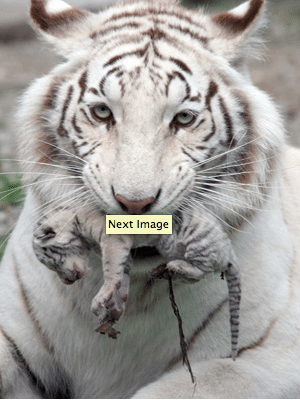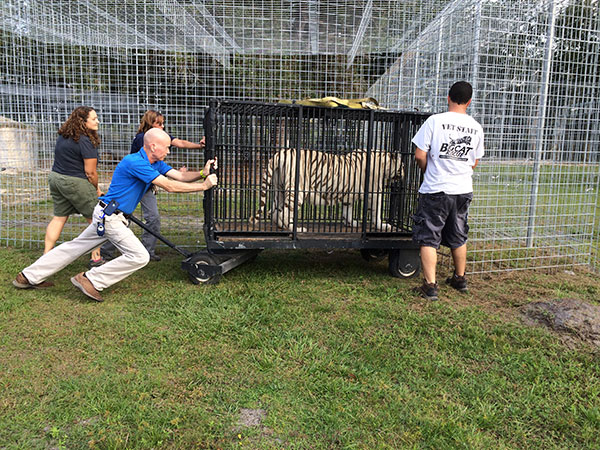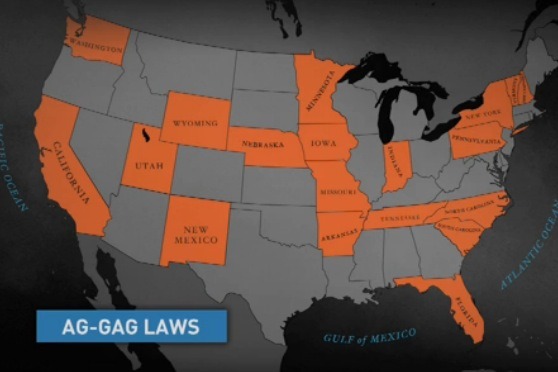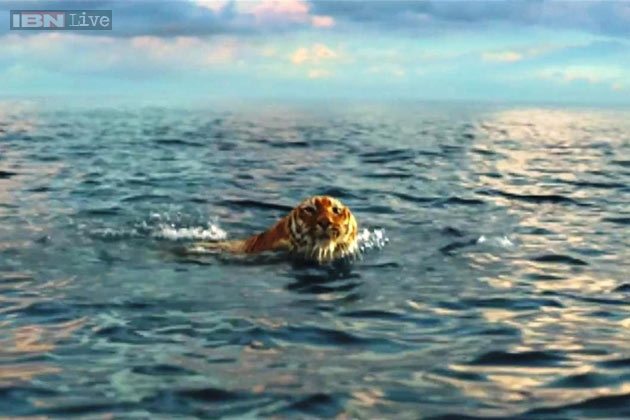Film a Rescue
How Can I Film a Rescue?
Before you contact Big Cat Rescue and ask if you can film a rescue, or film a few days of yourself working here, please consider the following:
Wild cats are as emotionally complex as humans; maybe even more so. A mother cat will kill her young rather than let them suffer, if they are born into a situation that is too unfavorable to their happy existence.
 Yet we use the term “tiger mom” to convey the fact that a tiger will fight to the death and sacrifice herself to protect her young, as will any other cat. Humans don’t usually cover that range of emotion. I don’t know of human mothers who chose to kill their babies rather than have them be enslaved, but big cats do it all the time. It is the excuse that big cat breeders use for taking the cubs as soon as they are born. They say the mother wouldn’t take care of the cubs, or might kill them.
Yet we use the term “tiger mom” to convey the fact that a tiger will fight to the death and sacrifice herself to protect her young, as will any other cat. Humans don’t usually cover that range of emotion. I don’t know of human mothers who chose to kill their babies rather than have them be enslaved, but big cats do it all the time. It is the excuse that big cat breeders use for taking the cubs as soon as they are born. They say the mother wouldn’t take care of the cubs, or might kill them.
That is your first clue that captivity is unbearable to the cat and that they believe their cubs are better off dead than in a cage.
People often want to do a story about those who keep wild animals as pets. In our industry we always say “you can train a big cat but you can never tame them,” because it is true. People do punish cubs, withhold food and water, and beat, kick and shock juvenile and adult exotic cats to make them appear tame, but no one ever tamed a wild cat and no one ever will.
The kind of people who breed these magnificent animals, for lives of captivity and deprivation; who steal the cubs from their mothers as soon as they are born; who force the cubs to eat food that is not sufficient for growing lion or tigers (you can’t buy tiger milk in the store and goat or cow milk is not a good substitute no matter how much other crap they add to the mix); who leave the cubs in tiny crates, only to pull them out for those who will pay to pose with them (usually holding a bottle to keep them quiet); who beat the cubs until they fear to ever bite or swipe at their trainer; these kind of people are not above lying to you. In fact, they have to lie to you and to the world, because no one would pay to see their shows, or think they were cool, if they showed you what they really do to the animal to make them comply.

They are usually illiterate, and you may think you can fool them into showing you what the animal’s life is really like, but they are smart about not letting outsiders see the truth and are great con artists. They will charm you and thrill you with the notion that if you train under them you too could be “special” and have a special relationship with the wild. More commonly, they will tell you they are saving the species, but none of the big cats in private hands is purebred or useful to conservation. It’s a lie, meant to separate you from your money, even if only $20 to get your photo taken with a cub. If they weren’t very good liars, they couldn’t keep fooling media outlets to promote their cruelty under the guise of “clean family fun,” or a “loving exotic pet owner.”
Big Cat Rescue gets pitched by production companies about once a week. Some have had great successes, with long running series and documentaries, others are new with no track record and school projects make up about half of the requests we get for filming opportunities. What they all want to film is a rescue and they almost all have their own talent, they want to be the focus of their piece, who will come in and spend a few days being a keeper to show the world what it’s like. Probably a quarter of the pitches we get are like yours, that say they want to “show both sides” of keeping wild animals in cages.
There are two sides, but not like most people think:
1. On the one side are people like us who understand that wild animals have their own needs, their own agenda and their own right, to make their own decisions. We are working to end captivity for them and save habitat so their kind can live free.
2. The other side makes money from them, or gets their sense of self worth from making other people think they are special. They say they love their animals, but what they love is the attention. They don’t want anyone to threaten their ability to keep fooling the public (they have to keep buying or breeding new cubs because once the cat is 5 years old they are an adult, and won’t put up with most of the imposed nonsense, like walking on a leash, unless they are brain damaged from the inbreeding or early beatings.)
 What the bad guys will show you is Operant Conditioning, or Positive Reinforcement, because they have to have some way of getting the cats to perform. What you can’t see, and wouldn’t know, is that those training methods only work if the cat is hungry or in the mood. If “the show must go on” then the real training that ensures performance is the cruelty you won’t see. The person will often carry a stick in their hand or back pocket and tell you that it is just for the cat to bite on, if they get too excited. The truth is that they use electric cattle prods during the real training sessions and then carry a similar looking stick into the cage, while you are looking, so the cat thinks they still have the electric prod.
What the bad guys will show you is Operant Conditioning, or Positive Reinforcement, because they have to have some way of getting the cats to perform. What you can’t see, and wouldn’t know, is that those training methods only work if the cat is hungry or in the mood. If “the show must go on” then the real training that ensures performance is the cruelty you won’t see. The person will often carry a stick in their hand or back pocket and tell you that it is just for the cat to bite on, if they get too excited. The truth is that they use electric cattle prods during the real training sessions and then carry a similar looking stick into the cage, while you are looking, so the cat thinks they still have the electric prod.
The thing is that you aren’t going to see what happens behind the scenes where animal abuse happens. Neither do the regulating bodies, like USDA or the state department of game, because they don’t do under cover work. Organizations that do undercover work have people who are willing to put in months, sometimes years, gaining the trust of these evil people, in order to capture footage that proves the bad treatment the cats go through.
This one just came out in January: https://www.humanesociety.org/news/press_releases/2015/01/ok-va-exotics-investigation-012215.html AFTER the HSUS aired their findings, then USDA went in and had to do their job of writing it up, but clearly USDA wasn’t able to figure it out without someone going inside, under cover, for months, so the idea that any film crew is just going to waltz in and get the bad guys to show themselves isn’t going to happen.
Whenever a film crew wants to film here we require they sign a contract with us that none of the footage they film here, or the many hundreds of hours we are often willing to share with them, will be used to promote the cruel notion that it is OK to keep wild animals in cages. That sends most of them packing, because they really want to perpetuate the myth that we can have tigers walk on leashes at our side and everything is great.
The main reason film crews contact us is that they want to film a rescue or film abuse.
That is pretty hard to do because most people have figured out that the general public thinks it is cruel to keep big cats in basements, garages and back yard jail cells. Most won’t let you in. Most of the film we get is done surreptitiously. Some sanctuaries will let you in, but most of the overcrowded, underfunded places aren’t going to let you in for the same reasons. You could come here, but our cages are 10 times or more larger than most and our cats have a great life, so it really doesn’t show how horrific the problem is.
Other questions we are often asked:
1. Are there lots of people still trying to buy tigers as pets?

The problem isn’t that there are a lot of people out looking to buy a tiger. The problem is that there are a lot of people who will pay to pet a tiger cub, or to swim with a tiger cub, or to have their photo with a tiger cub, or to see cute cubs on display.
They don’t stay small and cute very long, so the abusers are constantly breeding or buying more, but taking care of an adult tiger costs $10,000 a year, so the abusers will often give away their juvenile cubs, who have outgrown their cute stage, to unwitting people who think that just because they can walk that cub on a leash today, they will still be able to do it a year from now. When the cat is about a year old and over 200 lbs is when those owners often start looking for a sanctuary. Sometimes they end up being killed for their parts.
Sadly there are pseudo sanctuaries, like one we know of that has 300 tigers, who let the same bad actors breed cubs each year and then dump straight onto them. When we take a big cat we make the owners sign a contract that they will never possess another wild cat, but most sanctuaries don’t take that precaution and are just enabling bad behavior.
2. Where do they buy them?
We think two of the biggest suppliers of cubs are GW Zoo in Wynnewood, OK and T.I.G.E.R.S. in Myrtle Beach, SC, but it is nearly impossible to prove. USDA asks for a census, but it is up to the owner to say how many cats they have, because no one really counts them.
3. How often people are calling you because the want to get rid of a big cat?
2003 was the worst year. We had to turn away 312 big cats, but that same year a federal law passed that made it illegal to sell a big cat, over state lines, as a pet. Since then nearly a dozen states have passed bans on possession of big cats so the number we have to turn away is decreasing. Now the largest problem are all of these pseudo sanctuaries that fail after taking in more big wild animals than they can afford.
4. How do I know the good guys from the bad guys?
If they are breeding big cats for life in cages or posing with big cats, or letting you pose with big cat cubs, they they are part of the problem. You can search their names at www.911AnimalAbuse.com but a lot of them change their names and work under as many as 18 different business names so their bad actions are harder to trace back to them.
5. Can I volunteer while there?
We are serious about safety. We are a strictly NO TOUCH facility. No one touches the cats other than for medical treatment. Our volunteers spend 6 months getting trained before they can take care of our smallest cats. It is two years of classes and training with small cats before our volunteers ever get to clean and feed the lions, tigers and leopards. We wouldn’t dream of letting you breeze in and start working with wild cats with any less training.
6. Shouldn’t we be saving endangered species from extinction through captive breeding?
Allowing the private possession of lions, tigers, leopards and other wild cats is causing their extinction in the wild; not a hedge against it as the breeders would have you believe.
 If you haven’t read, or listened to Blood of the Tiger, by J.A. Mills, I think you should as it does a great job of tying in the U.S. trade in tigers and their imminent extinction in the wild.
If you haven’t read, or listened to Blood of the Tiger, by J.A. Mills, I think you should as it does a great job of tying in the U.S. trade in tigers and their imminent extinction in the wild.
https://www.amazon.com/Blood-Tiger-Conspiracy-Magnificent-Species/dp/0807074969
You can get it for free if you sign up for an Audible account.
So, as you can tell from this very long post, we would like to help and are happy to answer any questions you have or dispel any of the nonsense the breeders, dealers and exotic pet owners would have you believe.
We do allow anyone most people who want to film at our sanctuary the ability to do so. If they are a well known and respected production company, we do it for free. If they are trying to make a name for themselves, or are a school group, we usually suggest they book a private tour. Unlike other facilities, with something to hide, all of our sanctuary is available for filming, including our hospitals, our food prep areas, our offices, and of course the cats. The only cats we can’t take anyone near are the one or two that come in from the wild each year, that we are rehabbing for release back to the wild. Any animal going back to the wild has to stay away from people, so we can show you, via close circuit televisions, what is going on out there, but can’t expose them to visitors.
Private tours are expensive because we are a sanctuary, first and foremost, and we spend less than 20% of our revenue on staff and fundraising, so for someone to take the time to walk around with a private tour group answering questions, we have to make it worthwhile to the sanctuary.
We have our own media producer and more than 95,000,000 views of our footage on YouTube.com/bigcatrescue and are happy to share footage, at no charge, with those who are doing stories that will help us achieve our mission of ending the trade in big cats as pets, props and for their parts. You can contact our media person and others you may want to interview here: https://bigcatrescue.org/about/our-staff/ Most are happy to talk with you on camera.
This is a playlist of our rescue videos:






